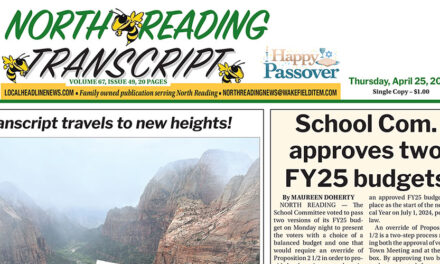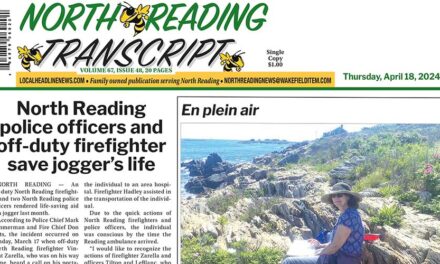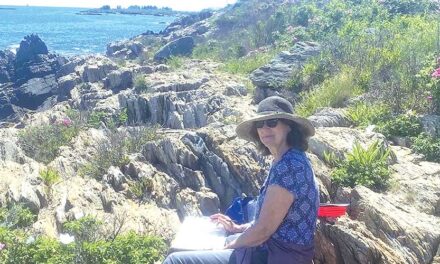Published in the March 24, 2016 edition
By BOB TUROSZ
NORTH READING – About 30 people attended last week’s informational hearing on the town’s plans to secure its water supply future starting in 2019 and for the foreseeable future.
As the Transcript has previously reported, including at last October Town Meeting, the town is eyeing a plan to join the MWRA district for a water supply connection with an effective date of 2019.
Why that’s necessary, how to get there and how much it will cost were some of the topics covered in last week’s 90 minute forum that included presentations from Town Administrator Michael Gilleberto, Selectman Michael Prisco and the town’s water consultants.
“This is an extension of the presentation we made last October,” Gilleberto said. “It’s to give everyone the opportunity to ask questions and become more informed on the process. And for us, it’s an opportunity to better educate the town as a whole.”
A key component of the plan is that North Reading connect to the MWRA system through the town of Reading, and that town’s DPW Director, Jeff Zager, was also present. The plan was presented by Rob Williamson and James Hoyt from Wright-Pierce, a water engineering firm.
North Reading needs to look at alternative water supplies because the town doesn’t have enough total capacity to meet its demand at peak times of the year now and that shortfall will only worsen in the future with additional growth, it was stated.
The town’s water supply system consists of its own groundwater wells that have a total, peak capacity of about 960,000 gallons a day and the ability to purchase up to 1.5 million gallons per day (mgd) from the town of Andover, for a total optimum water supply of 2.46 mgd. The major problem is that the town’s peak demand is 2.56 mgd, a deficit of 100,000 gallons per day now and in the future the deficit is projected to grow to 120,000 gallons per day.
These numbers don’t tell the whole story, said Williamson, because the town’s water sources at times can’t produce up to 30 percent of that 960,000 gpd. “The town’s supplies are tired and in very sore shape,” he said, as they are groundwater wells situated on small parcels of land. “They have served the community well, but they are nearing the end of their useful life.”
A deficit of 100,000 to 120,000 gallons a day may not sound like much to some, but it’s enough to keep Water Superintendent Mark Clark awake at night. That amount of water represents a 3 ft. deficit per day in the water storage towers or 20 feet total at the end of a dry, peak week. The water tanks can be down significantly within a week. Conservation is a huge part of any plan but it’s not enough to be North Reading’s solution for the future, he said.
The goals for the town’s future water supply system are for a long term, sustainable quality water supply with a simplified water system that can contain capital and operating costs, provide for future customers and reduce stress on the Ipswich River water basin, Williamson said.
Conservation alternatives were looked at and these should be part of any solution, Williamson said. But conservation alone won’t get North Reading where it needs to go. Similarly, the ability to purchase water from Andover is limited to 1.5 mgd under the terms of a permit issued by the state. To try to increase that would be “extremely difficult” and more importantly, Andover doesn’t have the capacity or infrastructure to step up its supply to North Reading, he said.
An obvious alternative would be to expand or optimize local sources but these are unreliable and with declining capacity and diminishing quality. There really are no large capacity groundwater sources remaining in North Reading, he said, and because the Ipswich River Water basin is stressed, the town will not be allowed by the state to increase its water withdrawals from the basin.
All of these factors have led to consideration of joining the MWRA, which has “an enormous water supply” with a supply and system that can serve 150 years, according to Williamson. In addition to plenty of capacity, the MWRA has redundancy and reliability on its side and shutting down North Reading’s wells would reduce the stress on the Ipswich River.
How would they get MWRA water to North Reading? By bringing it through Reading, which has a strong pipe network and infrastructure that could push water into North Reading. Pumping water from Reading into North Reading would require about 2.5 miles of pipe upgrades into a point in North Reading and that would become the town’s new supply, Williamson said. North Reading would maintain its Andover connections as back-ups and would shut down its existing supplies and facilities.
The MWRA is making a major investment in this part of its system to provide redundancy by starting construction of a second major pipeline from the south up to Reading, which means there will be two pipes feeding the system for both towns.
Water rates will rise either way
Water rates are going to rise whether the town’s decides to join the MWRA or not, Williamson said, because if the town decides to stay with its existing infrastructure, the projected cost is actually more expensive than joining the MWRA.
Selectman Prisco agreed but first he emphasized the MWRA plan is focused on water supply only, not sewerage. That (sewerage) is not happening” under this plan, he said.
“We are at a critical point, no matter what we do, we have to make an investment,” Prisco said.
Switching to MWRA service will cost about $17.1 million dollars over three years, he said, for nearly unlimited capacity that will satisfy the town’s future growth needs. The town will no longer be dependent upon Andover and will have reduced labor costs because certain positions in the water department will be unnecessary.
If the town decides not to join the MWRA, it’s looking at $21 million in costs over the next five years for same capacity it has today and which cannot support future growth. “If we wanted to put a hotel over on the Berry property, there’s no way we could satisfy that with the current water capacity we have.” North Reading has a contract with Andover that ends in 2019 and future rates are unknown. “It’s not going to be cheap if we stay this route and we will have no more water capacity than we do today,” he said.
“The most logical, affordable and positive impactful” decision is to join the MWRA but that won’t be cheap either and town officials did not try to obscure that fact.
7 percent increases for “multiple” years
Water rates would see significant increases of 7 percent a year for multiple years, TA Gilleberto advised. The estimated project cost is $9.45 million and can be bonded over 20 years with a zero percent interest loan. There is also a “buy-in” cost of $7.68 million to join the MWRA that would be financed by the MWRA and repaid by the town over 25 years with zero interest.
“This is a significant investment but we have to make it,” said Prisco. “We take that number very seriously and are actively pursuing grants and other assistance.”
This meeting was the start of a dialogue that will continue from now until Town Meeting in June. There will be another workshop held May 11 in the high school.
“This is a no-brainer, when you say $21 million to fix nothing vs. connecting up with the MWRA for less money,” said resident Cliff Bowers.




